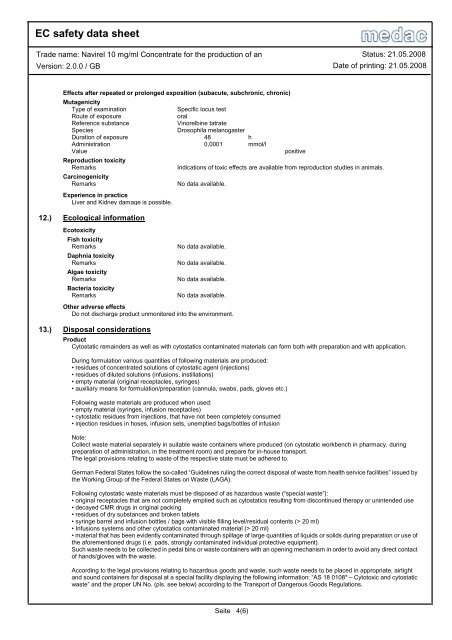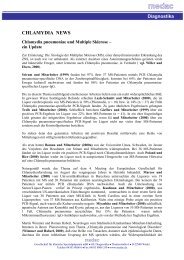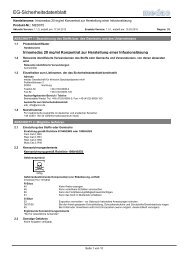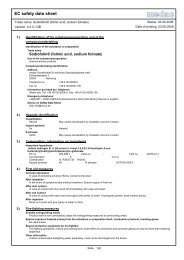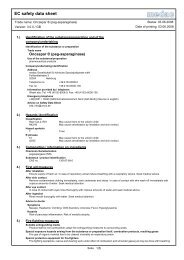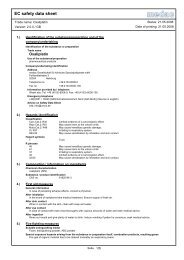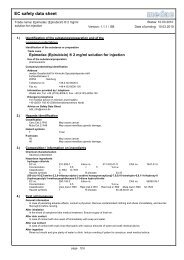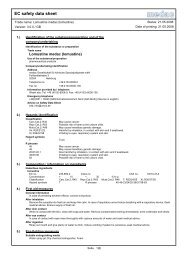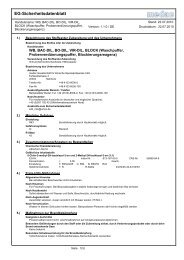Navirel - medac GmbH
Navirel - medac GmbH
Navirel - medac GmbH
Create successful ePaper yourself
Turn your PDF publications into a flip-book with our unique Google optimized e-Paper software.
EC safety data sheet<br />
Trade name: <strong>Navirel</strong> 10 mg/ml Concentrate for the production of an<br />
Version: 2.0.0 / GB<br />
Effects after repeated or prolonged exposition (subacute, subchronic, chronic)<br />
Mutagenicity<br />
Type of examination Specific locus test<br />
Route of exposure oral<br />
Reference substance Vinorelbine tatrate<br />
Species Drosophila melanogaster<br />
Duration of exposure 48 h<br />
Administration 0,0001 mmol/l<br />
Value positive<br />
Seite 4(6)<br />
Status: 21.05.2008<br />
Date of printing: 21.05.2008<br />
Reproduction toxicity<br />
Remarks Indications of toxic effects are available from reproduction studies in animals.<br />
Carcinogenicity<br />
Remarks No data available.<br />
Experience in practice<br />
Liver and Kidney damage is possible.<br />
12.) Ecological information<br />
Ecotoxicity<br />
Fish toxicity<br />
Remarks No data available.<br />
Daphnia toxicity<br />
Remarks No data available.<br />
Algae toxicity<br />
Remarks No data available.<br />
Bacteria toxicity<br />
Remarks No data available.<br />
Other adverse effects<br />
Do not discharge product unmonitored into the environment.<br />
13.) Disposal considerations<br />
Product<br />
Cytostatic remainders as well as with cytostatics contaminated materials can form both with preparation and with application.<br />
During formulation various quantities of following materials are produced:<br />
• residues of concentrated solutions of cytostatic agent (injections)<br />
• residues of diluted solutions (infusions, instillations)<br />
• empty material (original receptacles, syringes)<br />
• auxiliary means for formulation/preparation (cannula, swabs, pads, gloves etc.)<br />
Following waste materials are produced when used:<br />
• empty material (syringes, infusion receptacles)<br />
• cytostatic residues from injections, that have not been completely consumed<br />
• injection residues in hoses, infusion sets, unemptied bags/bottles of infusion<br />
Note:<br />
Collect waste material separately in suitable waste containers where produced (on cytostatic workbench in pharmacy, during<br />
preparation of administration, in the treatment room) and prepare for in-house transport.<br />
The legal provisions relating to waste of the respective state must be adhered to.<br />
German Federal States follow the so-called “Guidelines ruling the correct disposal of waste from health service facilities” issued by<br />
the Working Group of the Federal States on Waste (LAGA).<br />
Following cytostatic waste materials must be disposed of as hazardous waste (“special waste”):<br />
• original receptacles that are not completely emptied such as cytostatics resulting from discontinued therapy or unintended use<br />
• decayed CMR drugs in original packing<br />
• residues of dry substances and broken tablets<br />
• syringe barrel and infusion bottles / bags with visible filling level/residual contents (> 20 ml)<br />
• Infusions systems and other cytostatics contaminated material (> 20 ml)<br />
• material that has been evidently contaminated through spillage of large quantities of liquids or solids during preparation or use of<br />
the aforementioned drugs (i.e. pads, strongly contaminated individual protective equipment).<br />
Such waste needs to be collected in pedal bins or waste containers with an opening mechanism in order to avoid any direct contact<br />
of hands/gloves with the waste.<br />
According to the legal provisions relating to hazardous goods and waste, such waste needs to be placed in appropriate, airtight<br />
and sound containers for disposal at a special facility displaying the following information: “AS 18 0108* – Cytotoxic and cytostatic<br />
waste” and the proper UN No. (pls. see below) according to the Transport of Dangerous Goods Regulations.


